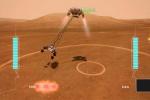A team of astronomers using NASA’s Hubble Space Telescope has discovered another moon orbiting the dwarf planet Pluto.
They say the new moon, Pluto’s 5th, is likely irregular in shape and 6 to 15 miles across. Provisionally designated S/2012 (134340) 1, it was detected in nine separate sets of images taken by Hubble’s Wide Field Camera 3 on June 26, 27, 29, and July 7 and 9. The moon circles Pluto in a 58,000 mile-diameter orbit.
Pluto’s largest moon, Charon, was discovered in 1978 in observations made at the United States Naval Observatory in Washington, D.C. Hubble observations in 2006 uncovered two additional small moons, Nix and Hydra. In 2011 another moon, P4, was found in Hubble data.
In the years following the New Horizons Pluto flyby, astronomers plan to use Hubble’s planned successor, NASA’s James Webb Space Telescope, for follow-up observations. The Webb telescope’s infrared vision will be able to measure the surface chemistry of Pluto, its moons, and many other bodies that lie in the distant Kuiper Belt along with Pluto.
For more information about New Horizons and its mission to Pluto visit http://science.nasa.gov/science-news/science-at-nasa/2012/13jul_pluto5/
Credit: Science News

 In collaboration with Microsoft Corp., a new outreach game was unveiled Monday to give the public a sense of the challenge and adventure of landing in a precise location on the surface. Called “Mars Rover Landing,” the game is an immersive experience for the Xbox 360 home entertainment console that allows users to take control of their own spacecraft and face the extreme challenges of landing a rover on Mars.
In collaboration with Microsoft Corp., a new outreach game was unveiled Monday to give the public a sense of the challenge and adventure of landing in a precise location on the surface. Called “Mars Rover Landing,” the game is an immersive experience for the Xbox 360 home entertainment console that allows users to take control of their own spacecraft and face the extreme challenges of landing a rover on Mars.

 The NASA Explorer School project was honored with an Emmy Award from the Lower Great Lakes Chapter of the National Association of Television Arts and Sciences on June 2, 2012. NASA Now, a weekly 5-7 minute video program is a classroom resource for teachers to show grades K-12 students what a scientist, engineer, or technician looks like, sounds like, and what kinds of work they do at NASA. Each week, students see real people putting science, technology, engineering and mathematics to work in the unique context of NASA careers, missions, research and facilities.
The NASA Explorer School project was honored with an Emmy Award from the Lower Great Lakes Chapter of the National Association of Television Arts and Sciences on June 2, 2012. NASA Now, a weekly 5-7 minute video program is a classroom resource for teachers to show grades K-12 students what a scientist, engineer, or technician looks like, sounds like, and what kinds of work they do at NASA. Each week, students see real people putting science, technology, engineering and mathematics to work in the unique context of NASA careers, missions, research and facilities.